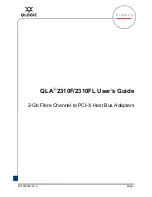
l
VLANs can co-exist with teaming (if the adapter supports both). If you do this, the team must be
defined first, then you can set up your VLAN.
l
The Intel PRO/100 VE and VM Desktop Adapters and Network Connections can be used in a switch
based VLAN but do not support IEEE Tagging.
l
You can set up only one untagged VLAN per adapter or team. You must have at least one tagged
VLAN before you can set up an untagged VLAN.
CAUTION:
When using IEEE 802 VLANs, settings must match between the switch and those
adapters using the VLANs.
NOTE
: Intel ANS VLANs are not compatible with Microsoft's Load Balancing and Failover (LBFO)
teams. Intel® PROSet will block a member of an LBFO team from being added to an Intel ANS
VLAN. You should not add a port that is already part of an Intel ANS VLAN to an LBFO team, as
this may cause system instability.
Configuring VLANs in Microsoft* Windows*
In Microsoft* Windows*, you must use Intel® PROSet to set up and configure VLANs. For more information,
select Intel PROSet in the Table of Contents (left pane) of this window.
NOTES:
l
If you change a setting under the Advanced tab for one VLAN, it changes the settings for
all VLANS using that port.
l
In most environments, a maximum of 64 VLANs per network port or team are supported by
Intel PROSet.
l
ANS VLANs are not supported on adapters and teams that have VMQ enabled. However,
VLAN filtering with VMQ is supported via the Microsoft Hyper-V VLAN interface. For more
information see
Microsoft Hyper-V virtual NICs on teams and VLANs
.
l
You can have different VLAN tags on a child partition and its parent. Those settings are
separate from one another, and can be different or the same. The only instance where the
VLAN tag on the parent and child MUST be the same is if you want the parent and child par-
titions to be able to communicate with each other through that VLAN. For more information
see
Microsoft Hyper-V virtual NICs on teams and VLANs
Power Management
The Intel® PROSet Power Management tab replaces the standard Microsoft* Windows* Power Management
tab in Device Manager. It includes the Power Saver and Wake on LAN* (WoL*) options that were previously
included on the Advanced tab. The standard Windows power management functionality is incorporated on the
Intel PROSet tab.
















































